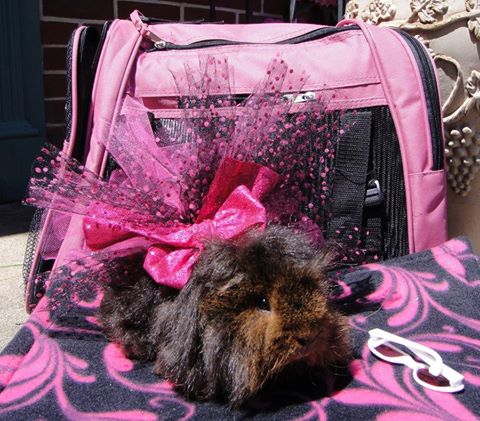
Use a pet carrier
Use a pet carrier. For two guinea pigs, the carrier should be at least 12 inches wide x 19 inches long x 12 inches high.
Do no substitute with another carrier and do no substitute with a cardboard box, small cage, open top tub, laundry basket, etc.
Cardboard boxes and things like laundry baskets aren't secure enough. There's too big of a risk of the guinea pig getting loose.
Small cages are not appropriate either, because they do not provide sufficient protection. The guinea pig will fly about a small cage if you make a sudden maneuver while transporting and likely
will get his/her feet caught in the cage wires, which can lead to serious injury.
What to put in the carrier?
Put paper bedding (see our bedding page), Aspen, a hand/dish towel, a puppy pad, or a fleece pad (fleece with an absorbent material attached) inside the bottom of the carrier.
Bring a backup so that you can replace the bedding, hand/dish towel, etc. if it becomes wet. Do not put anything in the carrier except the guinea pig, a serving of vegetables
(e.g., a leaf of romaine lettuce), and hay stuffed inside a toilet paper tube (optional). Do no put objects such as blankets, tunnels, cuddle sacks, pigloos, etc. in the carrier.
They will block ventilation and will put the guinea pig at risk of a heat related illness. Do not stuff the carrier with hay, which likewise will block ventilation.
A toilet paper tube worth of hay will be sufficient if you want to provide hay as a snack in the carrier.
What to attach to the carrier?
Do not attach a water bottle to the carrier. Water bottles tend to leak, especially when the carrier is being transported. Leakage will make the inside of the carrier wet and will cause the guinea pig to become wet.
Where to put the carrier in the car?
Traveling in hot or cold weather?
A guinea pigís environment should be kept at between 65 to 75 degrees F. When itís hotter or colder outside, youíll need to take precautions in transporting your foster.
Hot weather: Guinea pigs do not sweat, which means they have no natural way of cooling themselves. Additionally, having a natural body temperature higher than ours, guinea pigs may feel hot
and/or experience heat related illness when the temperature seems tolerable to us humans. To keep your guinea pig(s) cool:
Long trip?
Taking a long trip? Follow the above but also bring:
Copyright © 2011 - All Rights Reserved - Metropolitan Guinea Pig Rescue
Template by OS Templates